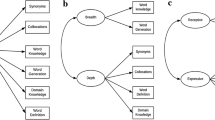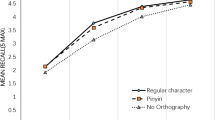Abstract
Vocabulary plays a critical role in language and reading development for children, particularly those learning English as an additional language (EAL) (Stahl & Nagy, 2006). Previous research on vocabulary has mainly focused on measuring individual words without considering multi-word phrase knowledge, despite evidence that these items occur frequently in English (Erman & Warren, 2000). Multi-word vocabulary knowledge and its contribution to literacy among children remains underexplored, possibly due to challenges presented in measuring this element of vocabulary and assessing children and learners with EAL. The current study adapted a test format designed for L2 adults (Revier, 2009) to develop a task measuring productive elements of English verb + object phrase knowledge. The measure was administered to 108 children (monolingual and EAL) between ages 7 and 10, along with a battery of standardized assessments. The measure possessed high internal consistency and temporal reliability, and correlated significantly with related vocabulary measures. Results showed significant differences among year groups and language backgrounds. Specifically, patterns in multi-word phrase knowledge across year group differ between children with EAL and monolingual English speakers. Findings are of import for understanding vocabulary acquisition and reading outcomes among both first and second language learners.


Similar content being viewed by others
References
Adams, C., Cooke, R., Crutchley, A., Hesketh, A., & Reeves, D. (2001). Assessment of comprehension and expression 6–11 (ACE 6–11). Windsor, UK: NFER-Nelson.
Bahns, J., & Eldaw, M. (1993). Should we teach EFL students collocations? System, 21, 101–114.
Barfield, A., & Gyllstad, H. (2009). Researching collocations in another language. Basingstoke, UK: Palgrave Macmillan.
Bialystok, E. (2010). Global–local and trail-making tasks by monolingual and bilingual children: Beyond inhibition. Developmental Psychology, 46, 93–105.
Biemiller, A. (2005). Size and sequence in vocabulary development: Implications for choosing words for primary grade instruction. In A. Hiebert & M. Kamil (Eds.), Teaching and learning vocabulary: Bringing research to practice (pp. 223–242). Mahwah, NJ: Erlbaum.
Bishop, H. (2004). Noticing formulaic sequences: A problem of measuring the subjective. LSO Working Papers in Linguistics, 4, 15–19.
Biskup, D. (1992). L1 influence on learners’ renderings of English collocations: A Polish/German empirical study. In P. J. L. Arnaud & H. Béjoint (Eds.), Vocabulary and applied linguistics (pp. 85–93). London, UK: Macmillan.
Bonk, W. J. (2001). Testing EAL learners’ knowledge of collocations. In T. Hudson & J. D. Brown (Eds.), A focus on language test development: Expanding the language proficiency construct across a variety of tests (technical report #21) (pp. 113–142). Honolulu, HI: University of Hawai’i, Second Language Teaching and Curriculum Centre.
Cain, K., & Towse, A. (2008). To get hold of the wrong end of the stick: Reasons for poor idiom understanding in children with reading comprehension difficulties. Journal of Speech, Language and Hearing Research, 51, 1538–1549.
Cain, K., Towse, A., & Knight, R. (2009). The development of idiom comprehension: An investigation of semantic and contextual processing skills. Journal of Experimental Child Psychology, 102, 280–298.
Chall, J. S., Jacobs, V. A., & Baldwin, L. E. (1990). The reading crisis: Why poor children fall behind. Cambridge, MA: Harvard University Press.
Church, K., & Hanks, P. (1990). Word association norms, mutual information, and lexicography. Computational Linguistics, 16, 22–29.
Conklin, K., & Schmitt, N. (2008). Formulaic sequences: Are they processed more quickly than nonformulaic language by native and nonnative speakers? Applied Linguistics, 29, 72–89.
Cooper, T. C. (1999). Processing of idioms by L2 learners of English. TESOL Quarterly, 33, 233–262.
Cunningham, A. E., & Stanovich, K. E. (1997). Early reading acquisition and its relation to reading experience 10 years later. Developmental Psychology, 33, 934–945.
Droop, M., & Verhoeven, L. (2003). Language proficiency and reading ability in first- and second-language learners. Reading Research Quarterly, 38, 78–103.
Dunn, L. M., Dunn, L. M., Whetton, C., & Pintilie, D. (1982). British picture vocabulary scale. Windsor, UK: NFER-Nelson.
Ellis, N., Simpson-Vlach, R., & Maynard, C. (2008). Formulaic language in native and second language speakers: Psycholinguistics, corpus linguistics, and TESOL. TESOL Quarterly, 42, 375–396.
Erman, B., & Warren, B. (2000). The idiom principle and the open choice principle. Text & Talk, 20, 29–62.
Farghal, M., & Obiedat, H. (1995). Collocations: A neglected variable in EFL. International Journal of Applied Linguistics, 28, 313–331.
García, G. E. (1991). Factors influencing the English reading test performance of Spanish-speaking Hispanic children. Reading Research Quarterly, 26, 371–392.
Gibbs, R. (1987). Linguistic factors in children’s understanding of idioms. Journal of Child Language, 14, 569–586.
Gibbs, R. (1991). Semantic analyzability in children’s understanding of idioms. Journal of Speech and Hearing Research, 34, 613–620.
Gibbs, R., Bogdanovich, J., Sykes, J., & Barr, D. (1997). Metaphor in idiom comprehension. Journal of Memory and Language, 37, 141–154.
Gyllstad, H. (2005). Words that go together well: Developing test formats for measuring learner knowledge of English collocations. In F. Heinat & E. Klingvall (Eds.), The department of English in Lund: Working papers in linguistics (Vol. 5, pp. 1–31). Lund, Sweden: University of Lund.
Hirsh, D., & Nation, P. (1992). What vocabulary size is needed to read unsimplified texts for pleasure? Reading in a Foreign Language, 8, 689.
Hu, H. M., & Nation, P. (2000). What vocabulary size is needed to read unsimplified Texts? Reading in a Foreign Language, 8, 689–696.
Hutchinson, J., Whiteley, H., Smith, C., & Connors, L. (2003). The developmental progression of comprehension-related skills in children learning. EAL Journal of Research in Reading, 26(1), 19–32.
Jaen, M. (2007). A corpus-driven design of a test for assessing the EAL collocational competence of university students. International Journal of English Studies, 7(2), 127–147.
Keshavarz, M. H., & Salimi, H. (2007). Collocational competence and cloze test performance: A study of Iranian EFL learners. International Journal of Applied Linguistics, 17, 81–92.
Kieffer, M., & Lesaux, N. K. (2012). Knowledge of words, knowledge about words: Dimensions of vocabulary in first and second language learners in sixth grade. Reading and Writing: An Interdisciplinary Journal, 25, 347–373.
Laufer, B. (1991). The development of L2 lexis in the expression of the advanced learner. The Modern Language Journal, 75, 440–448.
Lesaux, N. K., Rupp, C. K., & Siegel, L. S. (2007). Growth in reading skills of children from diverse linguistic backgrounds: Findings from a 5-year longitudinal study. Journal of Educational Psychology, 99, 821–834.
Levorato, M. (1999). Idiom comprehension in children: Are the effects of semantic analyzability and context separable? The European Journal of Cognitive Psychology, 11, 51–63.
Levorato, M., & Cacciari, C. (1992). Children’s comprehension and production of idioms: The role of context and familiarity. Journal of Child Language, 19, 415–433.
Levorato, M., & Cacciari, C. (1995). The effects of different tasks on the comprehension and production of idioms in children. Journal of Experimental Child Psychology, 60, 261–283.
Liontas, J. (2002). Context and idiom understanding in second languages. EUROSLA Yearbook, 2, 155–185.
Martinez, R., & Murphy, V. (2011). The effect of frequency and idiomaticity on second language reading comprehension. TESOL Quarterly, 45, 267–290.
Martinez, R., & Schmitt, N. (2012). A phrasal expressions list. Applied linguistics, 33, 299–320.
McKay, P. (2006). Assessing young language learners. Cambridge, UK: Cambridge University Press.
Mochizuki, M. (2002). Exploration of two aspects of vocabulary knowledge: Paradigmatic and collocational. Annual Review of English Language, Education in Japan, 13, 121–129.
Nation, I. S. (2001). Learning vocabulary in another language. Cambridge, UK: Cambridge University Press.
Nation, I. S. (2006). How large a vocabulary is needed for reading and listening? Canadian Modern Language Review/La revue canadienne des langues vivantes, 63, 59–82.
Nattinger, J. R., & DeCarrico, J. S. (1992). Lexical phrases and language teaching. Oxford, UK: Oxford University Press.
Nesselhauf, N. (2005). Collocations in a learner corpus. Amsterdam, Holland: Benjamins.
Nippold, M. A. (1998). Later language development: The school-aged and adolescent years. Austin, Texas: Pro-Ed.
Nippold, M. A., & Martin, S. T. (1989). Idiom interpretation in isolation versus context: A developmental study with adolescents. Journal of Speech and Hearing Research, 32, 59–66.
Nippold, M. A., Moran, C., & Schwatz, I. E. (2001). Idiom understanding in preadolescents: Synergy in action. American Journal of Speech and Language Pathology, 10, 169–179.
Nippold, M. A., & Rudzinski, M. (1993). Familiarity and transparency in idiom explanation: A developmental study of children and adolescents. Journal of Speech and Hearing Research, 36, 58–66.
Nippold, M. A., & Taylor, C. L. (1995). Judgments of idiom familiarity and transparency: A comparison of children and adolescents. Journal of Speech and Hearing Research, 45, 384–391.
Pawley, A., & Syder, F. (1983). Two puzzles for linguistic theory: Nativelike selection and nativelike fluency. In J. C. Richards & R. W. Schmidt (Eds.), Language and communication (pp. 191–226). London, UK: Longman.
Pearson, D. P., Hiebert, E. H., & Kamil, M. L. (2007). Vocabulary assessment: What we know and what we need to learn. Reading Research Quarterly, 42, 282–296.
Poulsen, S. (2005). Collocations as a language resource. A functional and cognitive study in English phraseology. Doctoral dissertation, University of Southern Denmark. Retrieved February 05, 2013, from http://static.sdu.dk/mediafiles/Files/Om_SDU/Fakulteterne/Humaniora/Phd/afhandlinger/2005/Afhandlinger%2048_s_poulsen%20pdf.pdf.
Read, J. (2000). Assessing vocabulary. Cambridge, UK: Cambridge University Press.
Revier, R. L. (2009). Evaluating a new test of whole English collocations. In A. Barfield & H. Gyllstad (Eds.), Researching collocations in another language (pp. 125–138). Basingstoke, UK: Palgrave Macmillan.
Rinaldi, W. (2000). Pragmatic comprehension in secondary school-aged students with specific developmental language disorder. International Journal of Language & Communication Disorders, 35, 1–29.
Roth, F. P., Speece, D. L., & Cooper, D. H. (2002). A longitudinal analysis of the connection between oral language and early reading. Journal of Educational Research, 95, 259–272.
Scarborough, H. S. (2001). Connecting early language and literacy to later reading (dis)abilities: Evidence, theory and practice. In S. B. Neuman & D. K. Dickinson (Eds.), Handbook of early literacy research (Vol. 1, pp. 97–110). New York, NY: Guilford Press.
Sinclair, J. (1991). Corpus, concordance, collocation. Oxford, UK: Oxford University Press.
Siyanova-Chanturia, A., Conklin, K., & van Heuven, W. J. (2011). Seeing a phrase “time and again” matters: The role of phrasal frequency in the processing of multiword sequences. Journal of Experimental Psychology. Learning, Memory, and Cognition, 37, 776–784.
Siyanova-Chanturia, A., & Martinez, R. (2014). The idiom principle revisited. Applied Linguistics. doi:10.1093/applin/amt054.
Stahl, S., & Nagy, W. (2006). Teaching word meanings. Mahwah, NJ: Lawrence Erlbaum.
Tannenbaum, K. R., Torgesen, J. K., & Wagner, R. K. (2006). Relationships between word knowledge and reading comprehension in third-grade children. Scientific Studies in Reading, 10, 381–398.
Vellutino, F. R., Tunmer, W. E., Jaccard, J. J., & Chen, R. (2007). Components of reading ability: Multivariate evidence for a convergent skills model of reading development. Scientific Studies of Reading, 11, 3–32.
Verhoeven, L. (1990). Acquisition of reading in a second language. Reading Research Quarterly, 25, 90–114.
Wechsler, D. (1992). Wechsler individual achievement test. San Antonio, TX: Psychological Corporation.
Wiig, E. H., & Secord, W. (1992). Test of word knowledge. USA: The Psychological Corporation.
Wray, A. (2002). Formulaic language and the lexicon. Cambridge, UK: Cambridge University Press.
Wray, A. (2008). Formulaic language: Pushing the boundaries. Oxford, UK: Oxford University Press.
Acknowledgments
We are grateful to all our participating schools, including teachers, staff, the young learners and their families. We would also like to thank Mairéad McKendry and Sibylla Leon Guerrero for their feedback and support. This study was supported by The International Research Foundation for English Language Education, Educational Testing Service and Funds for Women Graduates.
Author information
Authors and Affiliations
Corresponding author
Rights and permissions
About this article
Cite this article
Smith, S.A., Murphy, V.A. Measuring productive elements of multi-word phrase vocabulary knowledge among children with English as an additional or only language. Read Writ 28, 347–369 (2015). https://doi.org/10.1007/s11145-014-9527-y
Published:
Issue Date:
DOI: https://doi.org/10.1007/s11145-014-9527-y




